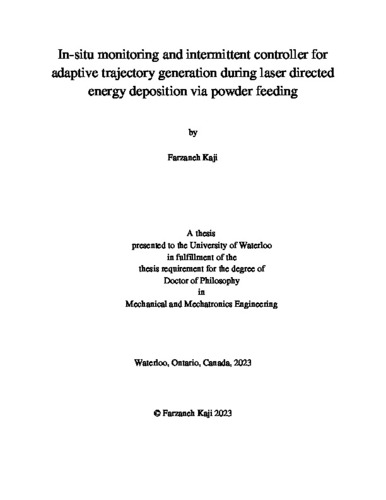UWSpace will be migrating to a new version of its software from July 29th to August 1st. UWSpace will be offline for all UW community members during this time.
In-situ monitoring and intermittent controller for adaptive trajectory generation during laser directed energy deposition via powder feeding
| dc.contributor.author | Kaji, Farzaneh | |
| dc.date.accessioned | 2023-03-27 17:34:07 (GMT) | |
| dc.date.available | 2023-03-27 17:34:07 (GMT) | |
| dc.date.issued | 2023-03-27 | |
| dc.date.submitted | 2023-03-16 | |
| dc.identifier.uri | http://hdl.handle.net/10012/19233 | |
| dc.description.abstract | Laser Directed Energy Deposition (LDED) is one of the advanced manufacturing technologies for building near-net-shaped engineering components in a layer-by-layer fashion using high-power lasers as an energy source. LDED using powder feeding (LDED-PF) is widely used due to its higher dimensional accuracy and ability to build fine features. The quality and performance of LDED-PF-built components are dependent on several factors such as process parameters, process conditions, feedstock properties, system configuration, tool-path generation, etc. Among the above, trajectory control is one of the emerging and active areas of research. Generally, trajectories are developed offline for printing the parts. However, some of the major challenges involved in conventional trajectory development for LDED-PF are the propensity for collision between the deposition head/ nozzle and the part being built and challenges in building components with variable overhang. The major goal of this work is the development of adaptive trajectory control of the LDED-PF process using online and offline techniques to build high-quality components. The work involves the offline trajectory development to build complex-shaped components with variable overhang angles by considering collision between the nozzle head and the part; adaptive layer thickness for higher dimensional accuracy. In addition, the work is extended to the development of online and intermittent trajectory control using a combination of in-situ surface quality monitoring and machine learning technique. Offline trajectory planning is performed for two complex-shaped geometries such as a hemispherical dome and a bent pipe. Offline adaptive trajectory planning for hemispherical dome involves the development of an algorithm including the deposition parameters with variable overhang and collision checking, while the trajectory planning for building bent pipe structures includes the deployment of adaptive slicing in addition to the collision check and overhang angle deposition. To manufacture the dome, the tilt angle is used to avoid the collision between the nozzle and previously built material with a condition that the tilt angle cannot exceed the maximum allowable overhang angle. The algorithm verifies the tilt angle suitable to build the dome and the angle is transferred from the tilt angle to the tilt angle of the rotary table. In order to build the bent pipe geometry, the variation in scanning speed is used to realize the adaptive slicing, which aids in having point-to-point variable layer height thereby permitting non-parallel deposition. In addition, changing the tool orientation during the deposition permits the manufacturing of support-free bent pipe parts as observed for dome structures. LDED-PF of the hemispherical dome and bent pipe was performed using the developed algorithms and the built geometries have good dimensional stability and density. In the case of online trajectory planning, a novel in-situ monitoring software platform was developed for the online surface anomaly detection of LDED-PF parts using machine learning techniques. The above starts with the development of a novel method to calibrate the laser line scanner with respect to the robotic end-effector with sub 0.5 mm accuracy. Subsequently, 2D surface profiles obtained from the LDED-PF built part surface using the laser scanner are stitched together to create an accurate 3D point cloud representation. Further, the point cloud data is processed, and defect detection is carried out using unsupervised learning and supervised (deep) learning techniques. Further, the developed defect detection software platform was used to create an online adaptive toolpath trajectory control platform to correct the dimensional inaccuracies in-situ. It uses a laser line scanner to scan the part after the deposition of the definite number of layers followed by the detection of concave, convex, and flat surfaces using deep learning. Further, the developed adaptive trajectory planning algorithm is deployed by using three different strategies to control material deposition on concave, convex, and flat surfaces. The material deposition is controlled by using adaptive scanning speed, and a combination of laser on-off and scanning speed. Subsequently, the built geometries are subjected to geometric, microstructure, and mechanical characterizations. The study offers an integrated and complete methodology for developing high-quality components using LDED-PF with a minimal dimensional deviation from the original CAD model. | en |
| dc.language.iso | en | en |
| dc.publisher | University of Waterloo | en |
| dc.title | In-situ monitoring and intermittent controller for adaptive trajectory generation during laser directed energy deposition via powder feeding | en |
| dc.type | Doctoral Thesis | en |
| dc.pending | false | |
| uws-etd.degree.department | Mechanical and Mechatronics Engineering | en |
| uws-etd.degree.discipline | Mechanical Engineering | en |
| uws-etd.degree.grantor | University of Waterloo | en |
| uws-etd.degree | Doctor of Philosophy | en |
| uws-etd.embargo.terms | 0 | en |
| uws.contributor.advisor | Toyserkani, Ehsan | |
| uws.contributor.affiliation1 | Faculty of Engineering | en |
| uws.published.city | Waterloo | en |
| uws.published.country | Canada | en |
| uws.published.province | Ontario | en |
| uws.typeOfResource | Text | en |
| uws.peerReviewStatus | Unreviewed | en |
| uws.scholarLevel | Graduate | en |

